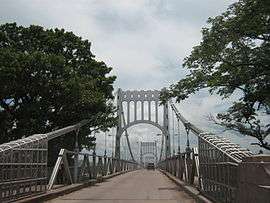Choluteca Bridge
Choluteca Bridge, or Carías Bridge, is a suspension bridge located in the city of Choluteca, Honduras. It is an emblem of the nation and the city where it is located. It was built between 1935 and 1937 by the United States Army Corps of Engineers using US and Honduran capital for the construction of the road named Panamericana. The bridge's importance is not simply a matter of size. The Choluteca Bridge is 300 meters long, but it isn't the longest in the country or even in the city—there is another bridge in Choluteca called The Bridge of the Rising Sun, which is 484 meters long.[2][3]
Choluteca Bridge | |
|---|---|
 Old Choluteca Bridge, 2005 | |
| Coordinates | 13.3116°N 87.1915°W |
| Crosses | Choluteca River |
| Locale | Choluteca |
| Maintained by | SOPTRAVI |
| Characteristics | |
| Design | Suspension |
| Material | Steel |
| History | |
| Designer | Conde B. McCullough, R. Archibald[1] |
| Construction start | 1935 |
| Construction end | 1937 |
| Opened | 1938, 2002 |

| |
Built during the reign of Tiburcio Carias Andino, with the co-operation of the government of the United States during the time when it was performed, it is considered to be one of the greatest works of architecture in the country.[4] The bridge is one of the few replicas of the Golden Gate Bridge that still exists,[3] and it controls the flow of traffic from Guatemala to Panamá. Partially destroyed by Hurricane Mitch in 1998, the bridge was remodelled in the year 2002 under the government of Ricardo Maduro.
New Choluteca Bridge
The new Choluteca Bridge, also known as the Bridge of Rising Sun, was built by Hazama Ando Corporation between 1996 and 1998 and became the largest bridge constructed by a Japanese company in Latin America.[5]
In the same year that the bridge was commissioned for use, Honduras was hit by Hurricane Mitch, which caused considerable damage to the nation and its infrastructure. Many bridges were damaged (including the old bridge) while some were destroyed, but the new Choluteca Bridge survived with minor damage. While the bridge itself was in near perfect condition, the roads on either end of the bridge had completely vanished, leaving no visible trace of their prior existence. More impressively, the Choluteca River (which is several hundred feet wide) had carved itself a new channel during the massive flooding caused by the hurricane. It no longer flowed beneath the bridge, which now spanned dry ground.[6] The bridge quickly became known as “The Bridge to Nowhere”.[7] In 2003, the bridge was reconnected to the highway.[8]
References
- "Suspension Bridges crossing Rio Choluteca".
- "A Bridge Where the River Flows No More". Archived from the original on 24 June 2015. Retrieved 24 June 2015.
- "La Nación".
- "Departamento de Choluteca (spanish)".
- "Japón dona 81 millones para ocho puentes en Honduras (Spanish)".
- Gelinas, Lillee. "The Choluteca bridge: What's wrong with this picture?". American Nurse Today. Retrieved 5 July 2015.
- http://www.huffingtonpost.com/joshua-macht/3-digital-publishing-less_b_7534872.html
- http://www.ad-hzm.co.jp/english/works/overseas/bridge/bridge_11.html